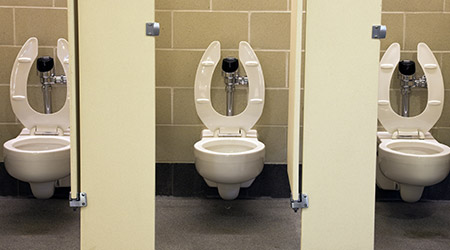
Cleaning restrooms is one of the most complex and challenging tasks that is performed on a daily basis due to the chemicals and procedures utilized. It is also one of the slowest tasks based on industry time standards when compared to vacuuming or even damp mopping. It is very important that restrooms, which have a small square footage compared to other areas, be cleaned and disinfected correctly each and every time it is serviced. Although the basic steps are the same regardless of size of the restroom, it is important that the safest, most effective tools and procedures be used for best results.
PPE's (personal protective equipment) may include appropriate gloves, a face mask and possibly an apron if harsh chemicals are used. Chemicals for daily use include an EPA registered disinfectant, glass cleaner, all purpose cleaner, metal cleaner/polish. Tools include color coded microfiber cloths, lamb's wool duster, dust pan/broom, damp mop bucket set. Consumable supplies include hand soap, paper towels, toilet tissue, can liners, napkin bags that are replaced as used. Equipment includes a restroom cart to transport/store supplies, collect trash.
Begin by closing off restroom once you have determined it is not being used. Spray/apply appropriate disinfectant inside toilets, urinals, along sinks to allow sufficient dwell time. Sweep floor, pick up litter/debris with attention to tops of partitions, vents, shelves and other dusty areas. Restock paper supplies, soap and other expendables. Using a bowl brush, scrub inside of toilets/urinals. Using disinfectant, clean the sink areas including faucets and well as spot cleaning around key touch points including light switch, stall latches and any observed areas that are soiled. Using glass cleaner, wipe down mirrors and metal surfaces if appropriate. Always use appropriate colored cloth to avoid cross contamination. Mop your way out of the restroom and remove barriers once floor is dry and safe to walk on.
Note that these suggested steps do not take into account periodic work such as pouring solution down drains, washing walls/vents, scrubbing floors, etc. Do you agree with this process? How would you do it differently?
Your comments and questions are important. I hope to hear from you soon. Until then, keep it clean...
Mickey Crowe has been involved in the industry for over 35 years. He is a trainer, speaker and consultant. You can reach Mickey at 678-314-2171 or CTCG50@comcast.net.
posted on 2/2/2018

 Celebrating BSCAI's 60th Anniversary eBook
Celebrating BSCAI's 60th Anniversary eBook The Down and Dirty on Cleaning in Virus Season
The Down and Dirty on Cleaning in Virus Season How Surfactant Use is Expanding in Commercial Cleaning
How Surfactant Use is Expanding in Commercial Cleaning